HTML
-
我国的船舶行业正面临着难得的发展机遇,但与发达国家在技术上尚有一些差距。我国的造船业存在很大的发展空间,不少高科技、高附加值船型、包括天然气船、大型液化石油气船、超大型集装箱船、豪华旅游船等尚处于开发阶段。豪华游艇目前已经成为世界船舶建造业的亮点,但是我国的游艇,包括长江三峡上的星级游艇,基本上都是外购。大部分船舶企业的焊接机械化、自动化焊接主要是半自动CO2焊、埋弧自动焊等,焊接机器人几乎等于零,因此处于自动化焊接的初级阶段,与日本、韩国相比存在较大的差距,尤其在机器人焊接方面存在较大的发展空间[1-3]。
我国大部分船厂在焊接厚板时,一般先要开坡口,然后用电弧焊进行多层多道堆焊,费时费力,而且由于增加了大量的热输入,容易使板材发生变形,残余应力也较大。激光焊接具有焊接速度快、穿透能力强、对环境污染小、材料变形小、易于实现自动化等特点,但由于纯激光光束直径较小,对接头精度要求较高,不能有太大的间隙和错边量,所以在船舶行业还没有大规模的使用。激光-熔化极惰性气体(metal inert-gas, MIG)复合焊是将激光束和电弧热源组合在一个工艺中,消除了两种焊接方式的缺点并结合了两种焊接方式的优点[4],既能保持较高的焊接速度、较大的深宽比,对接头又有较高的容忍度。因此,激光-MIG复合焊被广泛地运用于航空航天、船舶行业、汽车行业等领域[5]。
-
试验中采用厚度为7mm的AH36船舶钢,具有较高的强度、良好的耐腐蚀性能、焊接性能,母材屈服强度为401MPa,抗拉强度为555MPa,伸长率为28%,化学成分如表 1所示。AH36母材的显微组织如图 1所示。可以看出,AH36由大量铁素体和少量珠光体组成。
element mass fraction C 0.0017 Si 0.0026 Mn 0.0146 P 0.00018 S 0.00004 Nb 0.00001 Fe balance Table 1. Chemical composition and content of AH36 ship steel
试验中采用的焊丝为1.2mm的ER50-6焊丝,具有良好的刚直度、指向性,其化学成分如表 2所示。
element mass fraction C 0.0008 Si 0.0088 Mn 0.0152 S 0.00015 P 0.0002 Cu 0.002 Fe balance Table 2. Chemical composition and content of ER50-6 welding wire
试验中涉及到的激光-MIG复合焊设备属于龙门式机器人激光焊接系统,采用KUKA KR16型机器人,光纤激光器为IPG Photonics公司生产,型号为YLS-10000,光纤直径为200μm,输出激光功率最大为10kW,激光波长为1.064μm,焊机型号为TPS5000,系统整体图如图 2所示。
-
实验中采用单一变量法来研究激光功率对焊缝成型的影响,试验温度为室温,保护气体为Ar(质量分数为0.9999),接头形式为无间隙的平板对接。控制焊接速率为1.2m/min,电流为220A,正面保护气流量为20L/min。激光功率从4.5kW增大到7kW,每级增加500W,焊接完成后观察焊缝的宏观形貌特征,分析激光功率对焊缝成型的影响。不同功率的形貌图片如图 3所示。
由图 3可知,在激光功率为4.5kW时,正面焊缝出现了不均匀塌陷,背面焊缝出现了焊瘤缺陷,焊瘤的分布和焊瘤大小都不均匀,这是由于在焊接过程中,激光功率不足以完全焊穿7mm的板材,激光和电弧带来的能量使板材不均匀熔透,板材底部在熔透时,熔池在自身重力下下落,并凝固形成焊瘤,正面焊缝由于填充金属不足而出现塌陷;在激光功率为5kW时, 可以看到,正面焊缝也是有塌陷的现象,且伴有咬边缺陷,背部出现大小均匀的焊瘤[6],且焊瘤间的间距也是几乎相同的,这是因为在焊接过程中,激光能量刚好能够穿透板材,使板材处于适度熔透状态,激光和电弧带来的能量使板材周期性的被熔透,当板材被熔透时,熔池在自身重力的作用下下落,形成周期性的焊瘤;当激光功率为5.5kW时,可以看到,焊缝正面没有了塌陷的缺陷,正面成型较好,背部没有了大焊瘤,只有两个小突起,这是因为此时,激光能量能够完全穿透板材,小孔处于打开状态,随后,小孔在金属溶液表面张力的作用下迅速关闭,衬托住了上面的熔池,所以熔池没有下榻,产生小焊瘤的原因可能是因为激光与电弧能量没有匹配好,导致焊接过程不稳定,在某一点低于穿透板材的能量阈值,形成小焊瘤;当激光功率达到6kW时,激光与电弧能量匹配较好,焊缝正面和背面均无明显缺陷;当激光功率为6.5kW~7kW时,可以看到,焊缝背部有出现焊瘤的倾向,这是由于随着激光功率的增大,热输入量增加,熔融的金属量增加,熔池底部金属的表面张力不足以完全拖住上面熔池的重量,所以出现了焊瘤的倾向。
-
通过系统的工艺试验,得出7mm AH36船舶钢的最优工艺参量为:激光功率6kW,焊接速率1.2m/min,电流220A。最佳工艺参量时,7mm AH36船舶钢在不开坡口的情况下能一次性焊透,完成单面焊双面成型,且焊缝成型良好,无咬边、未熔合等缺陷,焊缝纹理清晰,焊缝成型如图 4所示。
试样表面经硝酸酒精(质量分数为0.03)腐蚀后,得到清晰的AH36对接焊缝横截面图片,如图 5所示。可以明显地看出激光-MIG复合焊的典型焊缝特征,上部宽大,呈现倒三角形,下部窄而长,其原因是焊缝上半部区域是在电弧的影响下形成的,电弧的能量比较分散,作用范围较大,所以形成的熔池较宽,焊缝下半部分区域是在激光作用下形成的,激光的能量密度大,通过小孔传递能量,所以形成的焊缝宽度较小。
-
激光电弧复合焊焊接接头主要分为母材(base metal,BM)、热影响区(heat affected zone, HAZ)、焊缝(weld metal, WM)3个区域,图 6为焊接接头放大25倍金相图。图 6a为对接接头下半部分激光作用区, 图 6b为对接接头上半部分电弧作用区。从两图中可以发现, 焊缝区组织成长方向是两侧是对称的,对称中心线为焊缝中心,大致与熔合线垂直,这是因为液态金属冷却时会沿着温度梯度最大的方向结晶,形成柱状晶,所以会与熔合线垂直;对比两图可以发现, 图 6a中的热影响区明显大于图 6b中的热影响区,这是因为激光作用区的接头处是以激光能量为主,电弧能量为辅,激光的线能量密度比电弧大得多,在焊接过程中实际的热输入量要比以电弧为主激光为辅的电弧作用区要小得多,所以热影响区也体现出上宽下窄的现象。
图 7为焊缝区放大1000倍显微组织图。可以看出, 电弧作用区的焊缝组织由大量板条状马氏体、少量贝氏体、少量块状铁素体组成,激光作用区的焊缝组织由大量板条状马氏体、少量贝氏体、微量铁素体组成。电弧作用区的板条状马氏体组织少于激光作用区的板条状马氏体组织,贝氏体和铁素体含量多于激光作用区的。在焊接过程中,电弧作用区主要是依靠电弧能量融化金属,电弧作用范围较广,热输入量较大,使得液态金属在高温相变点上停留时间较长,容易形成粗大的奥氏体组织[7]。在冷却过程中,冷却速度较慢,粗大的奥氏体组织形成板条状马氏体、贝氏体和少量铁素体组织;激光作用区主要是依靠高能量密度的激光融化金属,热输入量较少,液态金属在高温相变点上停留时间较短,奥氏体组织来不及长大[8]。该区在冷却过程中,温度梯度较大,冷却速度快,形成的马氏体、贝氏体、铁素体组织细小。
-
焊接接头拉伸试样根据金属材料室温拉伸国家标准,拉伸试样均断裂于母材,说明焊缝金属的抗拉强度高于母材的抗拉强度,测得抗拉强度为545MPa,接近AH36船舶钢抗拉强度的上限值,拉伸性能满足国家标准和中国船级社规范要求。
拉伸焊接接头拉伸试样的断口形貌如图 8所示。断口处颈缩明显,断口表面分布着大部分的等轴韧窝(见图 8a),小部分孔洞为母材原始缺陷,断口表现为韧性断裂(见图 8b)。
为了进一步了解焊缝性能特征,测试了焊缝的显微硬度。试验中取焊缝上部区域距离上表面2mm和焊缝下部区域距离下表面2mm处各取了21个点,取点硬度示意图如图 9所示。获得了母材区、热影响区、焊缝区硬度,其硬度测试值如图 10所示。
由图 10可知,熔合线上显微硬度约为393HV,热影响区显微硬度约为382HV,焊缝硬度约为385HV,母材硬度约为174HV。AH36激光-MIG复合焊所得焊接接头下方区域的硬度值整体高于上方对应区域的硬度值;其原因一为焊缝下部与金属工件台接触,散热快于焊缝上部,过冷度大,使得晶粒细化,强度硬度提高;原因二为焊缝上部分区域为电弧作用区,以电弧能量为主激光能量为辅,在电弧热源的影响下,相当于对焊缝上部分区域做了一次回火热处理。而电弧热源对焊缝下部分区域影响很小,所以对焊缝下部分区域没有回火作用,回火会导致焊缝硬度降低而塑韧性提高。从微观组织来看,焊缝上部分区域的铁素体含量要大于焊缝下部分区域,铁素体具有良好的塑形和韧性,而强度和硬度较低,所以焊缝上部分区域的硬度低于焊缝下部分区域的硬度。
还可以发现, 热影响区的硬度略高于焊缝区硬度,这是因为在熔池边界处有较大的温度梯度,液态金属冷却速率较快,会析出细小的碳化物弥散在基体上[10],使得热影响区的显微硬度增加。
焊缝区和热影响区的硬度均大于母材区,由上述微观组织分析可知,焊缝区由大量板条状马氏体,少量贝氏体,少量铁素体组成,而母材是由大量铁素体和珠光体组成,马氏体加贝氏体组织比铁素体加珠光体组织具有更高的强度和硬度,所以拉伸试验中断裂位置在母材,且焊缝区硬度比母材硬度高。
2.1. 激光功率对焊缝成型的影响分析
2.2. 宏观形貌分析
2.3. 微观组织分析
2.4. AH36激光-MIG复合焊接头力学性能分析
-
激光-MIG复合焊以其超高的优越性成为了我国高质量船舶制造进程中的必备焊接工艺,是我国从船舶制造大国向制造强国转变的必经之路。
通过使用万瓦级光纤激光器及福尼斯TPS5000焊机对7mm AH36进行了激光-MIG复合焊工艺试验研究,着重分析了激光功率对焊缝成型的影响,并对对接接头进行了力学性能测试。
(1) 背部焊瘤产生的原因是激光的不完全熔透,导致熔池金属在重力作用下突破底部熔池的表面张力,并冷凝产生了焊瘤。正面焊缝由于金属溶液的下落,导致正面塌陷。
(2) 得出7mm AH36船舶钢的最优工艺参量如下:激光功率6kW,焊接速率1.2m/min,电流220A,在此工艺下焊缝成型良好,无咬边、塌陷等缺陷。
(3) 激光-MIG复合焊对焊接接头的宏观形貌呈上宽下窄的特征,电弧作用区焊缝宽大成倒三角形,微观组织由大量板条状马氏体,少量贝氏体和少量块状铁素体组成,激光作用区焊缝细小而狭长,其中马氏体含量大于电弧作用区,所以显微硬度激光作用区要高于电弧作用区。
(4) 测得抗拉强度为545MPa,断裂于母材处,颈缩明显,其断口由大量等轴韧窝组成,为韧性断裂。

 Map
Map





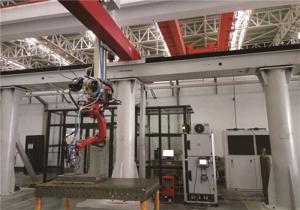
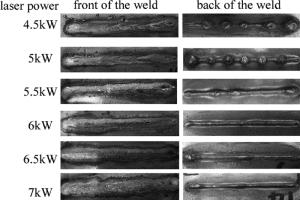

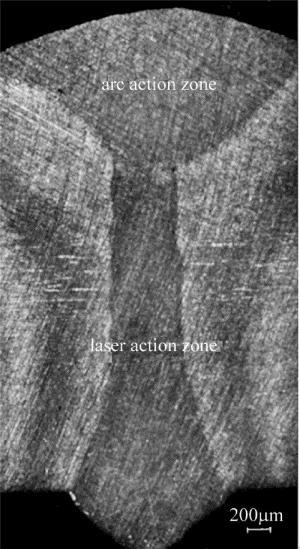
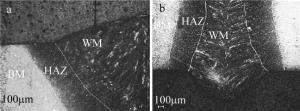
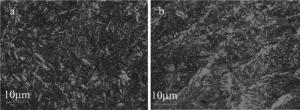
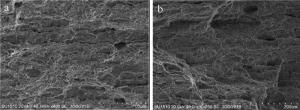
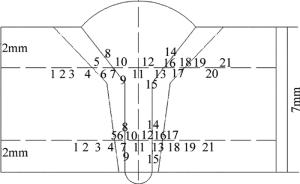
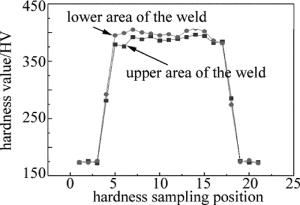
 DownLoad:
DownLoad:








